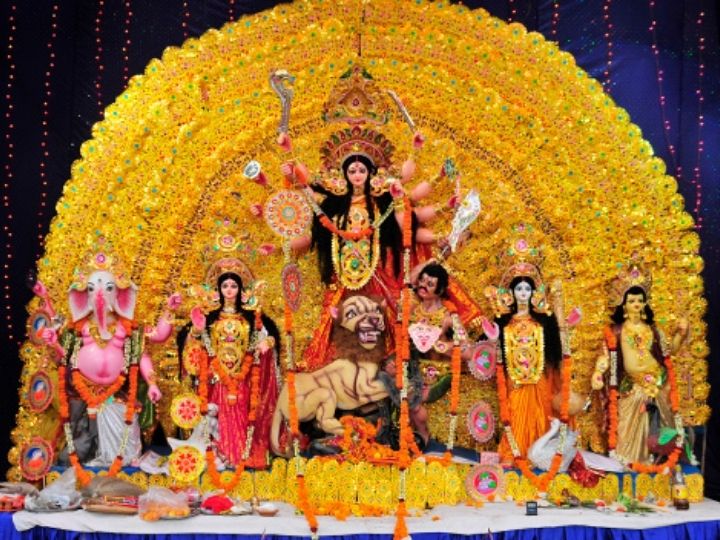Durga Puja 2021: As Devipaksha Begins, Know How Durga Idol Is Made And Rituals Followed In The Process
From 'pata puja' to 'praan prathishtha', there are various rites, rituals and protocols involved in the ‘making’ of a Durga idol. Know why clay from a prostitute’s home is used to make the idol

New Delhi: It is said Goddess Durga was created from the combined divine energies of the Holy Trinity — Shiva, Vishnu and Brahma — to eliminate the demon, Mahishasura, who had the divine blessing that he could not be killed by a ‘man’ or a ‘God’.
The ‘dashabhuja (10-armed)’ Goddess was given weapons such as the Chakra, Shankha, Trishula, Gada, Bow, Arrow, Sword, Shield and Bell by the many gods so She could take on the buffalo demon and save the universe from his atrocities.
Durga carried out the task She was created for, registering the victory of good over evil.
The annual Durga Puja festival is the commemoration of that win, and a celebration of the belief that the Goddess (the good) will continue to save Earth from the Mahishasura (the evil).
Devipaksha (the bright lunar fortnight in the month of Sharad) started on Thursday, a day after Mahalaya, and it is believed Durga has arrived already on her yearly trip to Earth, her ‘parental home’.
While the festival is celebrated during this time of the year, the preparations begin long before that.
The making of Durga idols is usually the most important time in the lives of clay sculptors engaged in the work, which begins months in advance — following all the rites, rituals and protocols.
While Durga Puja used to be a simple home-based affair in the past, it took the shape of a festival between the 16th and 17th centuries. And the art and process of making the idols, it is said, has since remained largely unchanged.
The Making Of Durga Idol
Devi Durga, astride a lion and attacking the Mahishasura, with her children Ganesh, Kartik, Lakshmi and Saraswati giving her company — every Durga Puja pandal depicts this scene, in their own way.
Accordingly, the sculptors need to make at least these seven figures even for a basic small-scale puja.
In Bengal, where Durga Puja is the biggest festival, the idol positioning used to be ‘ek-chala’ in the past, which meant all seven figures were placed under a single arch made of bamboo and wood. Multiple arches are used now at most places, and the organisers of the puja decide the positioning according to their preferences or the specific theme chosen for the year.
The process of making an idol usually begins with ‘Pata Puja’, on the day of the Rath Yatra that usually takes place around July. ‘Pata’ is the wooden frame that forms the base for the idols.
At some places, this puja also takes place on Janamshtami, another auspicious day.
In West Bengal, Kumortuli in capital Kolkata is a big hub of idol-making.
In the first stage of idol-making, the sculptors create the bamboo frame for all the seven figures — Durga, the lion, Mahishasura, Saraswati, Lakshmi, Ganesh and Kartik. Additionally, they need to make a swan for Saraswati, an owl that is Lakshmi’s ‘vaahan’, a mouse for Ganesha, and Kartik’s ‘vaahan’ peacock.
This skeletal frame is then filled with hay, which ensures the idols don’t become too heavy.
Then comes the time for use of the clay — a job that requires much skill and folowing of rules and protocols.
Traditionally, seven types of clay were mixed to make the final paste with which the idols were made.

Significance Of Soil From A Prostitute’s Home
A school of thought believes Durga must be worshipped along with ‘Navkanyas’, representing nine classes of women. They are: a ‘nati’, who is dancer or an actress), a ‘vaishya’ or prostitute, ‘rajaki’ or washerwoman, a ‘Brahmani (Brahmin girl)’, a ‘shudra’, and a ‘gopala’ or milkmaid.
This could be a reason why earth from a prostitute’s home is mixed with the clay that is used to make the idol of Durga.
In her book ‘In the Name of the Goddess’, Tapati Guha-Thakurta writes: “There is the curious ritual of including in this alluvial clay a lump of earth scooped from the threshold of a prostitute’s house, to sanctify in the process both the soil and the tainted locality from which it is drawn.”
She adds: “[A] month ahead of the Pujas, sex workers sell soil to the clay modellers at prices ranging between Rs.10–20 for a bag.”
These days, shops selling puja-related items keep the various kinds of soils for the sculptors to use.
Many believe that the soil collected from the threshold of a prostitute’s house is “pure” because people visiting such places giving in to carnal desires leave behind all virtues at the doorstep. The soil, it is believed, becomes blessed as it imbibes these people’s virtues.
The Final Clay Mixture
The clay from the prostitute’s home is mixed with that from a river bank, usually the Ganga in the case of Bengal, to make the final paste.
The hay-filled frame gets a layer of thick sticky clay that helps the sculptors give shape to the figures. Once it dries, another layer is applied and the body is carved.
Quoting Biswajit Pal, a veteran sculptor in West Bengal’s Krishnanagar, an article in Sahapedia said the artists prefer a special type of clay — a very smooth and soft kind — to make the face, hands and other intricate parts of the idols.
According to the article, jute fibres are kneaded into the clay to make the face and hands “sturdy yet pliable”.
For the final coat, a special moulding clay is used.
Once the clay dries up, the figures are said to be covered in white chalk paint and tamarind seed gum.
The mixture forms the binding for the different colours in which they are painted, according to Guha-Thakurta’s book.
It is then time to add hair, clothing, ornaments and weapons.
“The process culminates in the painting of the eyes of the central figure of Durga, marking the symbolic bringing to life of the icon—a ritual [called Chokkhodaan] that is most effectively played out on the morning of Mahalaya,” Guha-Thakurta writes.
According to Pal, the overall staging of the idols is incomplete without the mandatory placing of Shiva above Durga’s head, as a figure or a simple photograph. “...you can’t worship Durga without Shiva.”

Festival-Ready
Once the figures are all ready, the idols are taken to the pandals and installed at their allotted places, usually on Mahapanchami or Mahashasthi, that is the fifth or sixth day of Devipaksha.
It is the day of ‘praan pratishtha’ in the idols, which then turn into gods from simple clay figures. Priests doing the puja place in front of the idol a brass vessel symbolic of the Mother Goddess’ energy.
Mantras are chanted, hymns are recited, conch shells are blown, bells clang and lamps are lit to declare the festival open.
After five days of pujas and celebrations, Durga kills the Mahishasura before going back to Shiva’s abode, bidding a goodbye to Earth for another year.
Durga Puja 2021 Dates
Mahashasthi — October 11, 2021
Mahasaptami — October 12, 2021
Mahaashtami — October 13, 2021
Mahanavami — October 14, 2021
Vijaya Dashami — October 15, 2021





































